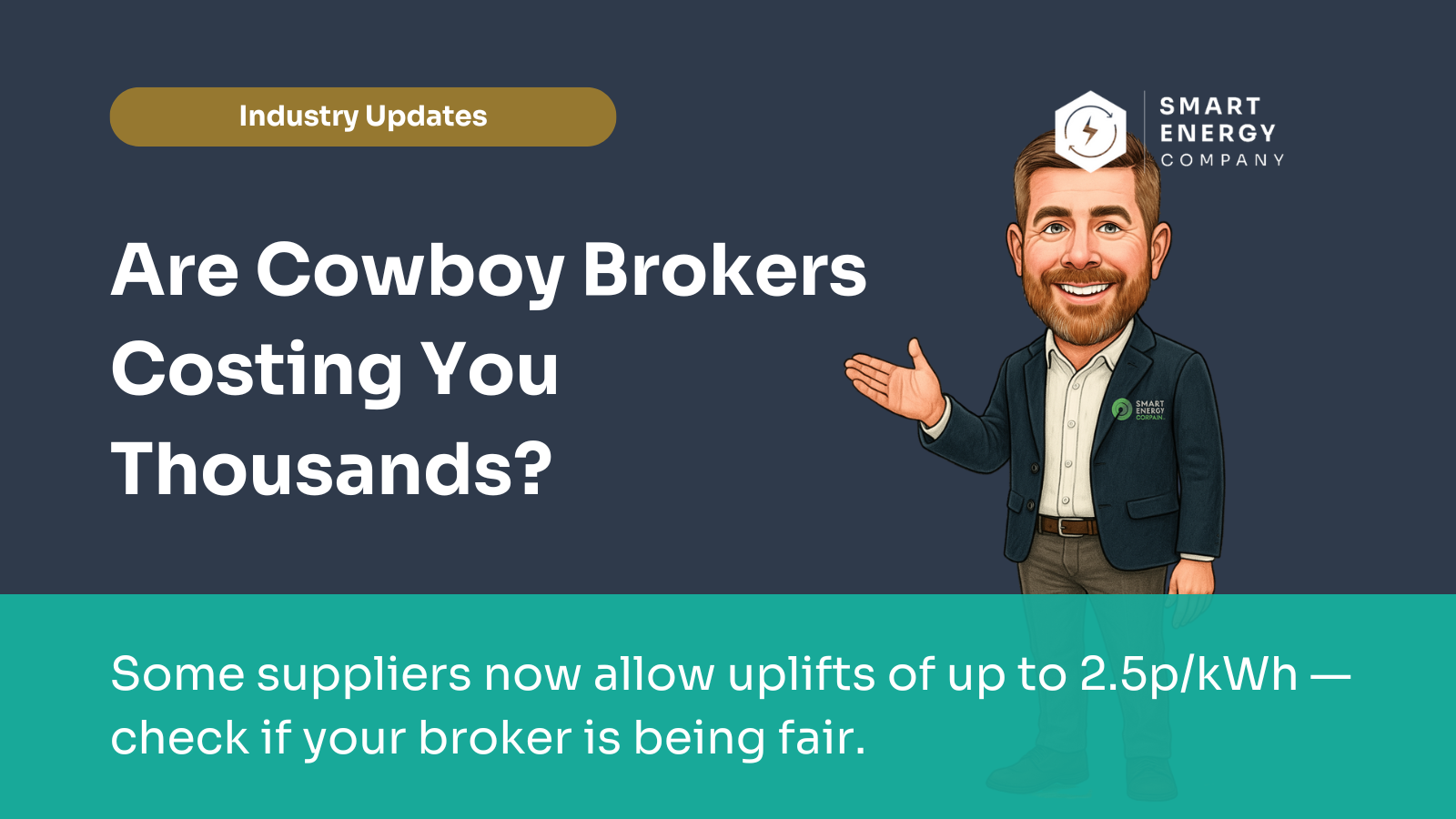Cowboy Brokers & Business Energy Contracts | Smart Energy
A supplier trial now allows uplifts of up to 2.5p/kWh. Here’s how cowboy brokers could exploit it — and how to protect your business.

With rising costs in the energy market, getting the cheapest business energy deal has never been more important. And with Ofgem’s recent regulation changes, it seemed like the days of cowboy energy brokers were finally behind us. After all, brokers now have to declare their commission uplifts in your contract.
But in a sharp turn of events, one major supplier has recently increased the maximum uplift a broker can apply – not reduced it. That means if a broker doesn't have your best interests at heart, they can now stack up to 2.5p/kWh on top of the base rates.
⚡ What Is an Energy Broker Uplift?
When a broker arranges your energy contract, they make their money by adding a small “uplift” to the supplier’s base rate. You don’t see this on your bill — you just see the total unit price.
For example, if the supplier’s base price is 4.00p/kWh and your broker adds 1.00p/kWh, your contract rate becomes 5.00p/kWh.
This might sound small, but when you multiply it across your annual usage, it can add thousands of pounds.
💰 What This Means in Real Money
Let’s look at a medium-sized restaurant using 178,000 kWh of gas a year.
- Base wholesale cost: 4.00p/kWh
- Fair uplift (0.50p): Total = 4.50p/kWh → Annual cost = £8,010
- High uplift (2.50p): Total = 6.50p/kWh → Annual cost = £11,570
👉 The higher uplift of 2.5p/kWh works out as £4,450 in broker commission every year — money that goes straight into their pocket.
And that’s just one site. For a business with multiple locations, the hidden cost multiplies fast.
🚩 Why This Is a Problem
A broker could present the higher-uplift contract as “favourable” while hiding cheaper tariffs from other suppliers, simply because it makes them more money.
Instead of suppliers tightening uplifts to protect businesses, this kind of change makes it easier for cowboys to profit — at your expense.
👉 Think You’re Paying Too Much?
Don’t let cowboy brokers line their pockets at your expense. Our Beat My Broker service shows you exactly what’s built into your quotes and helps you secure a fair deal.
🔍 Are You Really Seeing the Whole Market?
When your broker sends you quotes, ask yourself:
- Am I seeing all suppliers, or just the ones that make them the most money?
- Do I know what uplift is being added to each quote?
- Do the uplifts differ across the quotes, and if so, why?
If the answer to any of these is unclear, you may not be getting the transparency you deserve.
✅ How to Protect Your Business
- Always ask your broker to show their uplift in writing.
- Compare quotes from at least three suppliers (we compare over 28).
- Don’t be afraid to challenge why one quote is more expensive than another.
- Remember: the cheapest-looking deal isn’t always the cheapest if it’s loaded with commission.
🤔 Why Use a Broker at All?
It’s a fair question: if brokers can add uplifts, why use one in the first place?
Here’s the reality:
- Suppliers earn their profits from you directly. They’re multi-billion-pound companies posting record profits almost every year.
- Going direct doesn’t mean cheaper. In fact, suppliers often give brokers access to base rates that are lower than what you’d be offered directly.
- Market access matters. A broker can compare across dozens of suppliers quickly, instead of you phoning around one by one.
- Time is money. Procurement, contract management, renewals, and dispute resolution all take time. A good broker handles this for you.
- Consultative services add value. The right broker doesn’t just quote — they’ll advise you on timing the market, managing risk, and avoiding nasty out-of-contract charges.
✅ A good broker, working transparently, can save you thousands.
❌ But the higher the uplift, the less likely you’re actually saving by trusting blindly.
That’s why asking what uplift has been applied and shopping around is essential.
❓ Frequently Asked Questions
What is an energy broker uplift?
An uplift is the commission your broker adds onto the supplier’s base rate. For example, if the base rate is 4p/kWh and the broker adds 1p, you’ll pay 5p/kWh in your contract.
How much commission should I pay my energy broker?
There’s no fixed rule, but a fair uplift is usually less than 1p/kWh. Anything higher can add thousands to your annual bill, depending on your usage.
How can I check if my business energy contract is fair?
Ask your broker to show the uplift in writing and compare it across different quotes. Transparency is key — if they can’t (or won’t) show it, that’s a red flag.
Can I switch business energy suppliers if my broker adds too much commission?
Yes, as long as you’re not tied into a fixed-term contract. If you are, you’ll need to wait until your renewal window, but you can still get quotes in advance to make sure your next contract is fair.
What should I look for in a business energy contract?
Make sure you’re seeing all suppliers available to you, not just the ones your broker prefers. Check contract length, pricing type (fixed vs variable), and that any broker commission is clear and reasonable.
I don’t know how much uplift my broker has earned — what should I do?
If your broker hasn’t shown you their uplift in writing, you’re entitled to ask. Contact your supplier directly and request confirmation of the uplift that was applied to your contract.
Then go back to your broker and challenge them:
- Why did they choose that level of uplift?
- Do they think it’s fair given the service you’re receiving?
As a rule of thumb, anything over 1p/kWh should raise eyebrows. If your uplift is higher, you may not be getting the best value.
💡 Final Thoughts
Energy procurement should be about finding the best deal for you, not the biggest payday for a broker. Transparency isn’t optional — it’s your right.
👉 If you want to see exactly what’s built into your quotes and compare across the whole market, we’ll break it down for you in plain English.
Explore More Energy Insights
Stay informed with the latest market updates, supplier news, and industry changes affecting your business
Read our latest energy market insights and expert analysis
Your weekly energy market summary and price movements
Comprehensive monthly energy market trends and forecasts
Current deemed rates and how to avoid expensive bills
Latest news from UK energy suppliers and market changes
Important regulatory and industry updates for businesses
Found This Helpful?
Share this insight with your business network



